The Mediterranean Experience:
The Mediterranean as a spatial paradigm for the circulation of ideas and meaning.
An introduction.
Curator: Denys Zacharopoulos
Exhibition presented by the Macedonian Museum of Contemporary Art in the context of the main program of the 4th Thessaloniki Biennale of Contemporary Art.
The exhibition will be open on Tuesday 17 September 2013.
Duration: 18 September – 31 December 2013 The Mediterranean Experience: The Mediterranean as a spatial paradigm for the circulation of ideas and meaning. An introduction. Curator: Denys Zacharopoulos Exhibition presented by the Macedonian Museum of Contemporary Art in the context of the main program of the 4th Thessaloniki Biennale of Contemporary Art. The exhibition will be open on Tuesday 17 September 2013. Duration: 18 September – 31 December 2013 The Macedonian Museum of Contemporary Art presents, in the context of this year’s fourth edition of the Thessaloniki Biennale of Contemporary Art, the exhibition « The Mediterranean experience: The Mediterranean as a spatial paradigm for the circulation of ideas and meaning. An introduction », curated by Denys Zacharopoulos. The exhibition will open to the public on 17 September 2013 and will be visitable on the 18th of September, when the official inauguration of the 4th Thessaloniki Biennale of Contemporary Art will take place. As the artistic director of Macedonian Museum of Contemporary Art, Denys Zacharopoulos notes: « The subject of ‘the Mediterranean’ has been extensively researched by the greatest historians of the twentieth century. In our exhibition « The Mediterranean experience: The Mediterranean as a spatial paradigm for the circulation of ideas and meaning, » we did not intend to follow a Braudelian approach or ponder on the composition of the cultural environment of a region that lies, in every conceivable way, at the crossroads of Europe, Asia and Africa. Our approach and research are different; they are based on an intuition, which does not aspire to any kind of composition or even analysis, but simply represents an initial, tentative, critical and systematic taxonomy of our material. Our ambitions are rather modest. We have consciously limited ourselves to the collection of evidence, facts and works, purposely avoiding generalizations, ideological constructs and the pervasive folkloric depictions of the Mediterranean. Our definition of the Mediterranean experience is about people and things that are not directly related to the Mediterranean as a geographical and historical notion. The history of forms which focuses on quotidian practices and social representations, impressions, experiences and mentalities, now represents an important chapter of historical research, which deals with everyday life. Only rarely, however, are artistic practices and individual artworks studied in connection to the mentalities of everyday life. Even more rarely does art history recognize that artists, from Gustave Courbet onwards, emanate from or participate in everyday life and that their work is inspired by and addressed to their surrounding reality. Had it done so, it would have allowed one to realize that the experiences and practices of everyday life permute, or occasionally overturn, the standards and norms of intellectual, specialized artistic practice. »
The exhibition features works from the following artists: Marina Abramovi?, Art and Language, Isabelle Arthuis, Nikos Alexiou, Dimitris Alithinos, Alexis Akrithakis, Stephen Antonakos, Mona Breede, Alighiero Boetti, Miros?aw Baika, Marie Jos? Burki, Daniel Buren, Lothar Baumgarten, Marcel Broodthaers, Herbert Brandl, Pedro Cabrita Reis, Pier Paolo Calzolari, G?rard Collin-Thiébaut, Vlassis Caniaris, Lizzie Calligas, Ernst Caramelle, Lawrence Carroll, Cherif et Silvie Defraoui, Jimmie Durham, Diohandi, Danil, Diego Esposito, Donald Evans, Lionel Estève, Angus Fairhurst, Michel François, Agnès Fornells, Gaylen Gerber, Apostolos Georgiou, Rodney Graham, Giannis Gaitis, Giorgos Gyparakis, George Hadjimichalis, Giorgos Harvalias, Panos Haralambous, Lisa Haver, Jenny Holzer, Ann Veronica Janssens, Alain Jacquet, Mike Kelley, Ed Kienholz, Dionisis Kavallieratos, Joseph Kosuth, Tadashi Kawamata, Peter Kogler, Eleni Kamma, Aris Konstantinidis, Martin Kippenberger, Dimitris Kozaris, Nikos Kessanlis, William Klein, Niki Kanagini, Nikos Kouroussis, Richard Long, Jim Lutes, Robert Longo, Anna Lascari, Stathis Logothetis, George Lappas, Yorgos Lazongas, Matt Mullican, Juan Munoz, Come Mosta-Heirt, Reinhard Mucha, Cildo Meireles, Miltos Manetas, Eliseo Mattiacci, Erwan Mah?o, Max Neuhaus, NSK, Xavier Noiret-Thom?, Stratos Dontsis, Rivane Neuenschwander, Nikos Navridis, Gabriel Orozco, Meret Oppenheim, Dennis Oppenheim, Pino Pascali, Manfred Pernice, Emmanuel P?reire, Michelangelo Pistoletto, Maria Papadimitriou, Ilias Papailiakis, Leda Papaconstantinou, Rena Papaspyrou, Ulf Rollof, Jean-Pierre Raynaud, Patrick Raynaud, Chryssa Romanou, Thomas Struth, Thomas Schutte, Kostas Sahpazis, Remo Salvadori, Joe Scanlan, Adrian Schiess, Mariella Simoni, Georgia Sagri, Yorgos Sapountzis, Vasilis Skylakos, Kyrillos Sarris, readymades belong to everyone®, Filippos Tsitsopoulos, Petros Touloudis, Dimitris Tsoumplekas, Thanasis Totsikas, Takis, Theodoros, Henk Visch, Vassilis Vassilakakis, Franz West, Lawrence Wiener, Daniel Walravens, Constantin Xenakis, Georgios Xenos, Gilberto Zorio.
A special edition will published to accompany the exhibition. The exhibition team: Curator: Denys Zacharopoulos, Artistic Director, MMCA
Eleni Kamma
Systèmes de construction II , 2008
Two stop-motion animation films projected simultaneously next to each other, 3:40 min
Systèmes de construction II is a proposition on how to look into a book. I produced a 50 page notebook by manually copying, page after page, the reproduction of a 15th century Turkish decorative tile. Going through the notebook from left to right, the form of the tile slowly shifts to Mondrian’s Boogie Woogie. From right to left, Boogie Woogie’s reproduction slowly shifts back to the Turkish tile. Confronted with the finished form of this notebook, in order to lower the inherent elements of this type of narrative object (the book with a beginning and an end, hierarchies),I decided to produce a stop-motion film consisting of two parts, projecting simultaneously next to each other two different versions of the same action: turning the pages of the notebook. Although this animation emphasizes the transformative nature of the notebook, the coexistence of the two asymmetrically mirrored parts disrupts and confuses the rhythm of the turning pages. The coexistence of the two equal-in-size projections produces a third space that superimposes itself on them, giving the final rhythm to the piece.(Eleni Kamma)
[sociallinkz]
